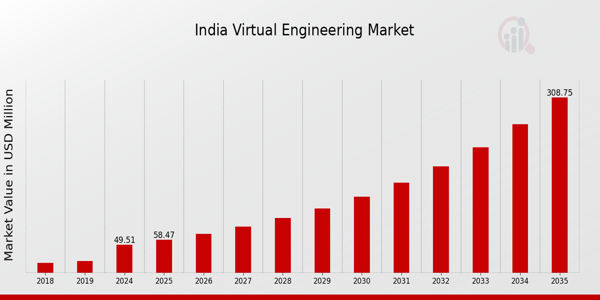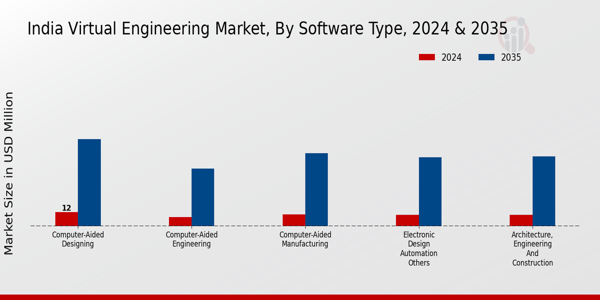India Virtual Engineering Market Overview
As per MRFR analysis, the India Virtual Engineering Market Size was estimated at 42.77 (USD Million) in 2023.The India Virtual Engineering Market Industry is expected to grow from 49.51(USD Million) in 2024 to 308.76 (USD Million) by 2035. The India Virtual Engineering Market CAGR (growth rate) is expected to be around 18.104% during the forecast period (2025 - 2035).
Key India Virtual Engineering Market Trends Highlighted
The India Virtual Engineering Market is experiencing a substantial increase in growth, which is being driven by the widespread adoption of automation and the advancements in digital technologies in a variety of sectors. Companies are progressively employing virtual engineering to improve productivity and decrease operational costs in response to the emergence of Industry 4.0. Virtual engineering is a critical component in optimizing design and manufacturing processes, as the government's pursuit of "Make in India" and the Indian Digital Industry Policy is cultivating an environment that is conducive to technology adoption and innovation.
This market offers a plethora of opportunities that should be investigated. The expansion of industries such as aerospace, automotive, and construction offers organizations the opportunity to capitalize on virtual engineering to enhance their simulation and modeling capabilities. Additionally, the ongoing emphasis on smart city initiatives in India presents an opportunity for the integration of virtual engineering applications into urban planning and infrastructure development.
This will allow stakeholders to more effectively visualize and analyze projects prior to their implementation. Recent trends suggest a transition to collaborative engineering solutions, which prioritize team engagement across various geographical locations. This method not only improves efficiency but also fosters the burgeoning remote work culture that has been influenced by the pandemic.
Furthermore, the prevalence of cloud-based solutions is facilitating real-time collaboration among engineering teams, thereby simplifying the process of sharing complex designs and modifications in an instant. In general, these trends underscore a transformative period for the India Virtual Engineering Market, which is closely aligned with the country's broader economic and technological objectives.

India Virtual Engineering Market Drivers
Rising Demand for Advanced Design Solutions
The India Virtual Engineering Market Industry is witnessing significant growth due to the increasing demand for advanced design solutions across various sectors such as automotive, aerospace, and manufacturing. Industries are increasingly adopting virtual engineering techniques to enhance product design and innovation.
According to the Department of Heavy Industry, the share of electric vehicles in India's total vehicle sales is projected to increase to 30% by 2030.This shift requires advanced engineering and digital modeling capabilities, which further boosts the demand for virtual engineering solutions. Major organizations like Tata Consultancy Services and Wipro have started exploring and investing in virtual engineering to meet these evolving needs, thereby driving market growth.
Government Initiatives Promoting Digital Infrastructure
The Indian government's commitment to enhancing digital infrastructure is playing a crucial role in the growth of the India Virtual Engineering Market Industry. Initiatives like 'Digital India' aim to transform India into a digitally empowered society and knowledge economy.
As part of this initiative, significant investments are being made in developing the necessary infrastructure, educational policies, and technical centers. The government reported an investment of 1.1 trillion INR (approximately 15 billion USD) in the digital sector over five years, which is expected to catalyze the adoption of virtual technologies and engineering solutions in various industries.
Growth of the Manufacturing Sector
The manufacturing sector in India is projected to grow significantly, which subsequently boosts the India Virtual Engineering Market Industry. The Ministry of Commerce and Industry indicated that the manufacturing output in India is expected to touch 1 trillion USD by 2025, benefiting from initiatives like the 'Make in India' campaign.
This growth in manufacturing necessitates the use of virtual engineering for process optimization, simulation, and product development.Numerous companies such as Larsen and Toubro are leveraging virtual engineering technologies to improve efficiency, reduce time-to-market, and enhance quality, contributing to the overall expansion of the market.
India Virtual Engineering Market Segment Insights
Virtual Engineering Market Software Type Insights
The India Virtual Engineering Market has witnessed significant growth, particularly in the Software Type segment, which encompasses a variety of specialized applications crucial for different engineering processes. This segment includes vital components such as Computer-Aided Designing (CAD), Computer-Aided Manufacturing (CAM), Computer-Aided Engineering (CAE), Architecture, Engineering, and Construction (AEC), Electronic Design Automation (EDA), among others. With the rapid advancement in technology and the increasing demand for efficient and precise engineering solutions, the Software Type segment is seeing robust traction across various industries in India, including manufacturing, construction, automotive, and electronics.
CAD plays an instrumental role by enhancing design accuracy and efficiency, making it a cornerstone in engineering workflows. The CAM software complements this by streamlining manufacturing processes, which is particularly essential in India's burgeoning manufacturing sector, known for its push towards “Make in India” initiatives. Meanwhile, CAE tools are indispensable for simulation and analysis, aiding industries in testing designs under different conditions without the need for physical prototypes. This not only speeds up the development cycle but also reduces costs, thereby improving overall productivity.The AEC software segment is gaining attention, especially as urbanization in India accelerates, with a growing focus on infrastructure development through smart cities and sustainable building projects.
EDA tools are critical for the electronics industry, supporting the design and verification of integrated circuits and systems, thereby propelling innovation in one of India's most significant sectors. The market trends indicate a shift towards integrated software solutions that combine these functionalities, reflecting the industry's need for holistic approaches to design and production processes.India's strong IT infrastructure and skilled workforce further catalyze the growth of the Software Type segment in the virtual engineering landscape.
To summarize, the Software Type segment of the India Virtual Engineering Market presents a diverse range of tools and solutions that are essential for enhancing efficiency, productivity, and innovation across various sectors. The ongoing digital transformation is expected to create ample opportunities for these software solutions, catering to the specific needs and challenges faced by industries in India.

Virtual Engineering Market Deployment Type Insights
The India Virtual Engineering Market demonstrates noteworthy potential, particularly within the Deployment Type segment. This segment is primarily divided into two prominent areas: On-premises and Cloud solutions. On-premises deployments have traditionally offered businesses enhanced control over their infrastructure and data security, making them a preferred choice for industries that handle sensitive information. However, Cloud-based solutions are gaining traction due to their scalability, cost-effectiveness, and flexibility, allowing businesses to adapt quickly to changing market demands.The Indian government has been advocating for digital transformation and cloud adoption, which is driving the growth of Cloud-based virtual engineering solutions.
The seamless integration of advanced technologies like Artificial Intelligence and the Internet of Things within the Cloud segment enhances operational efficiency and innovation across various industries. Moreover, the increasing reliance on remote work due to recent global trends positions Cloud deployments as a significant driver in the evolution of virtual engineering. The dynamics of these deployment types reflect an evolving landscape where businesses in India can increasingly leverage technology to enhance their engineering capabilities, thus significantly influencing the overall market landscape and offering numerous opportunities for growth and development in the industry.
Virtual Engineering Market Organization Size Insights
The Organization Size segment of the India Virtual Engineering Market is characterized by a dynamic landscape, with significant distinctions between small and medium enterprises (SMEs) and large enterprises. SMEs play a crucial role in driving innovation and adopting virtual engineering solutions, as they leverage these technologies to optimize processes and enhance product development efficiencies. This segment has shown an increasing inclination towards embracing digital tools, which is supported by government initiatives promoting technological adoption among smaller businesses.Conversely, large enterprises dominate the market by utilizing advanced virtual engineering for complex projects, enhancing competitive advantages through improved Research and Development capabilities.
The scalability offered by virtual engineering solutions is significant for both segments, as it enables organizations to respond effectively to market demands and evolving consumer preferences. The rise in digital transformation efforts across various sectors further boosts the adoption of virtual engineering practices in India, indicating strong growth potential within both SMEs and large organizations.Thus, the Organization Size segment stands out as a pivotal aspect of the India Virtual Engineering Market, reflecting varying adoption rates and deployment strategies across different company sizes.
Virtual Engineering Market Application Insights
The Application segment of the India Virtual Engineering Market showcases a diverse range of functions that cater to various industries, playing a crucial role in technological advancement. Automation Design has gained significant traction, driven by the rising demand for efficiency and productivity in manufacturing processes. Plant Design focuses on optimizing layouts and workflows, enhancing operational efficiency in sectors such as energy and manufacturing. Product Design stands out as a vital aspect, supporting innovation and creativity in bringing new products to market swiftly while ensuring user satisfaction.
The 3D Modeling application is essential in visualizing and simulating designs, enabling organizations to identify potential issues before physical implementation, thereby reducing costs and time. Other applications contribute to the overall versatility of the market by addressing specific niche requirements across industries. The growth of the digital economy in India fosters an environment ripe for advancements in these applications, offering numerous opportunities for businesses to leverage virtual engineering for competitive advantage.
With the government's focus on initiatives like "Make in India," there is an upward trajectory in adopting these technologies to enhance industrial landscape efficiency.Overall, the integration of these applications within the virtual engineering framework results in improved processes and product offerings, illuminating the path toward a more technologically-driven future.
Virtual Engineering Market Industry Vertical Insights
The Industry Vertical within the India Virtual Engineering Market showcases a robust framework, characterized by its influential segments such as the Commercial and Defense sectors. The commercial segment plays a pivotal role in facilitating efficiency and innovation across various industries, including manufacturing, automotive, and consumer goods, as companies leverage virtual engineering solutions to enhance product design and reduce time-to-market. Conversely, the Defense sector commands significant attention, driven by advancements in simulation, modeling, and analysis to develop sophisticated defense systems and to maintain national security.
As India's defense expenditure continues to grow, the demand for virtual engineering technologies is expected to surge, enabling improved operational capabilities. The integration of digital twins and advanced simulation techniques further underlines the importance of these segments, as they enable accurate predictions and risk assessments, ultimately fostering safer and more effective operations. The segmentation into Commercial and Defense verticals reflects the diverse applications of virtual engineering, driving growth and innovation in India’s economy, making it a vital aspect of the overall market dynamics.
India Virtual Engineering Market Key Players and Competitive Insights
The India Virtual Engineering Market has experienced significant growth and transformation in recent years, driven by advancements in technology and the increasing demand for innovative solutions across various industries. With a competitive landscape marked by both local and international players, the market exhibits a diverse range of offerings, including software and services aimed at streamlining design, simulation, and collaborative processes. The focus on enhancing productivity while reducing operational costs has prompted many organizations in India to adopt virtual engineering solutions, fostering an environment of intense competition.
Market participants are increasingly differentiating their products and services through enhanced functionalities, integration capabilities, and superior customer support, aiming to address the unique challenges faced by different sectors.PTC has established a notable presence in the India Virtual Engineering Market, leveraging its comprehensive suite of solutions tailored for product development and lifecycle management. The company’s strengths lie in its robust software offerings, particularly in the areas of computer-aided design (CAD), product data management (PDM), and Internet of Things (IoT) integration, which cater to the evolving needs of Indian manufacturers and engineers. PTC’s commitment to innovation is reflected in its consistent upgrades and enhancements to its software products, ensuring they remain at the forefront of the industry.
The company’s strategic partnerships with local businesses and educational institutions further bolster its competitive advantage, allowing PTC to adapt its solutions to the unique demands of the Indian market, thus reinforcing its market presence.Oracle also plays a significant role in the India Virtual Engineering Market, offering a range of services that encompass cloud applications, analytics, and database technologies. Known for its enterprise resource planning (ERP) systems and data management solutions, Oracle has positioned itself as a key player involving advanced technologies that enhance operational efficiencies for organizations.
The company has a broad market presence facilitated by strategic mergers and acquisitions, enabling it to integrate new capabilities and expand its reach within the Indian market. Oracle’s strengths include its extensive portfolio of cloud services and advanced analytics tools that provide Indian organizations with data-driven insights, leading to improved decision-making. With a focus on innovation and customer-centric solutions, Oracle continues to enhance its offerings to address the specific needs of the Indian virtual engineering landscape, reinforcing its competitive position in the market.
Key Companies in the India Virtual Engineering Market Include:
- PTC
- Oracle
- Geometric Limited
- Siemens
- Ansys
- Zebra Technologies
- HCL Technologies
- Altair Engineering
- L&T Technology Services
- Wipro
- Dassault Systemes
- MathWorks
- IBM
- Tata Technologies
India Virtual Engineering Market Industry Developments
Volvo Cars designated Tata Technologies as a strategic supplier in June 2025. This collaboration concentrates on embedded software, product lifecycle management (PLM) solutions, vehicle system and component engineering, and product engineering.
The partnership is designed to improve Volvo Cars' global engineering capabilities by leveraging Tata Technologies' scalable delivery models and extensive domain expertise.HCL Technologies announced in July 2023 that it had acquired a 100% equity stake in ASAP Group, a German-based provider of automotive engineering services. This acquisition expands HCL Technologies' capabilities in the automotive engineering sector.
Siemens declared its intention to acquire Altair Engineering for $10.6 billion in October 2024. By integrating Altair's simulation software with Siemens's hardware offerings, this acquisition is intended to strengthen Siemens' position in the swiftly expanding industrial software market, thereby improving digital and real-world product projections.
India Virtual Engineering Market Segmentation Insights
Virtual Engineering Market Software Type Outlook
-
- Computer-Aided Designing (CAD)
- Computer-Aided Manufacturing (CAM)
- Computer-Aided Engineering (CAE)
- Architecture, Engineering and Construction (AEC)
- Electronic Design Automation (EDA)Others
Virtual Engineering Market Deployment Type Outlook
Virtual Engineering Market Organization Size Outlook
Virtual Engineering Market Application Outlook
-
- Automation Design
- Plant Design
- Product Design
- 3D MODELLING
- Others
Virtual Engineering Market Industry Vertical Outlook
-
- Commercial Industry Vertical
- Defense Industry Vertical
| Report Attribute/Metric Source: |
Details |
| MARKET SIZE 2023 |
42.77(USD Million) |
| MARKET SIZE 2024 |
49.51(USD Million) |
| MARKET SIZE 2035 |
308.76(USD Million) |
| COMPOUND ANNUAL GROWTH RATE (CAGR) |
18.104% (2025 - 2035) |
| REPORT COVERAGE |
Revenue Forecast, Competitive Landscape, Growth Factors, and Trends |
| BASE YEAR |
2024 |
| MARKET FORECAST PERIOD |
2025 - 2035 |
| HISTORICAL DATA |
2019 - 2024 |
| MARKET FORECAST UNITS |
USD Million |
| KEY COMPANIES PROFILED |
PTC, Oracle, Geometric Limited, Siemens, Ansys, Zebra Technologies, HCL Technologies, Cibrex, Altair Engineering, L&T Technology Services, Wipro, Dassault Systemes, MathWorks, IBM, Tata Technologies |
| SEGMENTS COVERED |
Software Type, Deployment Type, Organization Size, Application, Industry Vertical |
| KEY MARKET OPPORTUNITIES |
Increased demand for remote collaboration, Growth in automotive simulation technologies, Adoption of AI in engineering processes, Expansion of virtual prototyping tools, Rise in training and education solutions |
| KEY MARKET DYNAMICS |
Growing demand for digital solutions, Rise in automation technologies, Enhanced focus on R&D investment, Increasing adoption of cloud computing, Expansion of engineering services outsourcing |
| COUNTRIES COVERED |
India |
Frequently Asked Questions (FAQ):
In 2024, the India Virtual Engineering Market is expected to be valued at approximately 49.51 million USD.
By 2035, the India Virtual Engineering Market is projected to reach a valuation of around 308.76 million USD.
The market is expected to grow at a compound annual growth rate (CAGR) of 18.104 percent from 2025 to 2035.
The Computer-Aided Designing (CAD) segment is expected to lead with a value of 75.5 million USD in 2035.
Major players include PTC, Oracle, Siemens, Ansys, and HCL Technologies among others.
The Computer-Aided Manufacturing (CAM) segment is valued at approximately 10.1 million USD in 2024.
The AEC software segment is expected to generate about 60.5 million USD in revenues by 2035.
In 2024, the Electronic Design Automation (EDA) segment is anticipated to be valued at around 9.81 million USD.
The CAE segment is expected to grow from 8.0 million USD in 2024 to 50.0 million USD in 2035.
Increased digitalization and adoption of automation in engineering processes are driving growth in the market.
















